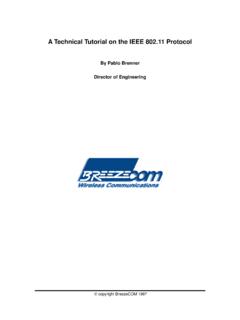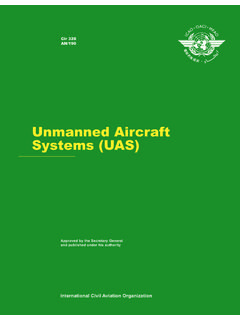Transcription of RR906 - Collision and injury criteria when working with ...
1 Health and Safety Executive Collision and injury criteria when working with collaborative robots Prepared by the Health and Safety Laboratory for the Health and Safety Executive 2012 RR906 Research Report Health and Safety Executive Collision and injury criteria when working with collaborative robots Human Science Group Health and Safety Laboratory Harpur Hill Buxton Derbyshire SK17 9JN There is a need for adequate protection of people from the health and safety risks associated with collaborative robot systems. Standard ISO 10218 (Parts 1 and 2) and a draft Technical Specification TS 15066 collaborative robots have been developed to deal specifically with this situation. This study explored the safety, reliability and evidence for the force limits defined by the draft TS 15066, and of the methods for testing them.
2 It also addressed whether the proposed approach in the draft TS 15066 is likely to adequately protect people from the risks. Risk assessment of potential Collision scenarios, human reliability and behaviour issues, and equipment failure modes and rates are discussed, as is the adequacy of personal protective equipment against Collision injuries. collaborative robots is an subject area that is still growing. This report and the work it describes were funded by the Health and Safety Executive (HSE). Its contents, including any opinions and/or conclusions expressed, are those of the authors alone and do not necessarily reflect HSE policy. HSE Books Crown copyright 2012 First published 2012 You may reuse this information (not including logos) free of charge in any format or medium, under the terms of the Open Government Licence.
3 To view the licence visit , write to the Information Policy Team, The National Archives, Kew, London TW9 4DU, or email Some images and illustrations may not be owned by the Crown so cannot be reproduced without permission of the copyright owner. Enquiries should be sent to ii STRUCTURE OF THIS REPORT KEY MESSAGES What the study findings mean for the customer Main messages / lessons inferred from the study MAI N F I NA L RE P O R T 1. CONTEXT Outline of the problem the study aims to address, & the study background. 2. IMPLICATIONS What the study findings mean for the customer & other stakeholders of the study 3. APPROACH Description of the study design, data sources & analysis techniques 4. FINDINGS Summary of results that relate directly to the study implications, highlighting themes & messages 5.
4 REFERENCES 6. BIBLIOGRAPHY Useful literature not referenced to in the report 7. ANNEX Attached document containing appendices & additional information. Technical details on the Approach Significant raw data & supporting information that should be recorded & kept with the report Results from the study not directly related to the Implications EXECUTIVE SUMMARY Description of how the study was done & what was found, highly condensed to meet the needs of the busy reader iii iv KEY MESSAGES This study sought to answer the question of whether the approach adopted in the draft Technical Specification ISO/TS 15066 collaborative robots is likely to sufficiently and realistically protect people from the risks of working with collaborative robots, and be practical to implement.
5 The literature search carried out for the study revealed an extensive amount of research in the collaborative robots subject area, and was more than expected. Consequently this study was not in a position to categorically answer the questions that were posed at the outset because the amount of data that needed to be reviewed in detail was far in excess of the limits of this study, but significant steps have been made towards achieving well-informed answers by providing an initial appraisal of the research and scoping out a path to achieve more fully informed answers. The study has brought to light a number of points, including: Although the force limits stated in the draft standard have been based on a review of over 200 literature sources, and seem on the safe side , issues with conducting research on human tolerance to injury and pain, along with issues of individual variability, affect the validity of the available research for determining force tolerance limits.
6 Psychological, behavioural and organisational aspects affecting the level of human- robot Collision risk are recognised in the literature, but not strongly represented in the draft standard at present. The effects of human movement velocities are also not represented. Some within the industry are of the opinion that customised injury criteria are required, rather than use of the Abbreviated injury Scale and ICD-10 criteria . Currently the frequency of injury is not included in the criteria for acceptable Collision limits. Investment in standardised instrumentation and methods is under development discussions on the practicality and cost of development, distribution and training in use might need to take place. An additional output from the study was a draft categorisation structure for the range of subject areas that are relevant to development of the draft ISO/TS 15066 standard.
7 It is envisaged that this will be of benefit to managing the extensive range of research and information on collaborative robots, and to tackling the questions that are posed. The study has some implications for potential additions to the draft ISO/TS 15066, and these have been presented for consideration in section of the Implications section. There may be value in further and deeper consideration of several topic areas than was possible within the constraints of this study. These are described in section Possible next steps . v vi EXECUTIVE SUMMARY Robotic machinery and people are increasingly working in close proximity within industrial workspaces and there is a need for adequate protection of people from the health and safety risks associated with collaborative robot systems.
8 This has led to the development of standard ISO 10218 (Parts 1 and 2) and a draft Technical Specification TS 15066 collaborative robots to deal specifically with this situation. The current study aims to address the following: a) Whether force limits defined in the draft TS 15066 are safe & realistic; b) Whether methods proposed in the draft TS 15066 for testing the force limits are likely to be reliable, realistic and pragmatic for risk assessment of collaborative robot systems under real circumstances; c) Whether the proposed approach in the draft TS 15066 is likely to adequately protect people from the risks. Methods The current state of research on the body s tolerance to various applied forces was investigated by literature search, and the force tolerance values in the draft TS 15066 compared with those found in the literature.
9 Contact with the developers of the proposed force values was made in order to establish how the force values had been derived. The Personal Protective Equipment (PPE) specialists at the Health & Safety Laboratory (HSL), Buxton, UK were consulted as to whether it is reasonable to assume that PPE can adequately protect the ears, eyes, nose and mouth from injury when working with robots in foreseeable working scenarios. To consider the practicality of the proposed measurement and risk assessment methods in the draft TS 15066, the availability of appropriate measurement components and devices was investigated. Consideration was given to the measurement approaches adopted in other standards, and to practical issues that could affect the validity and reliability of the testing and risk assessment methods proposed.
10 Whether the approach proposed in the draft TS 15066 would adequately protect people from the risks of working with collaborative robots was addressed by considering the proposed force limits in conjunction with real scenarios of human- robot collaborative working , and the potential risks. Real scenarios of collaboration and associated risks were gathered from internet sources and accident reporting. Findings The developers of the force limit values that are proposed in the draft TS 15066 had reviewed over 200 literature sources, providing confidence that the values are based on thorough consideration of the research available. However, it is apparent from the literature that: a) there are significant gaps in the research; b) that there are ethical issues that constrain the quality of the data that can be gathered, and; c) it is a research area that is still growing.

















